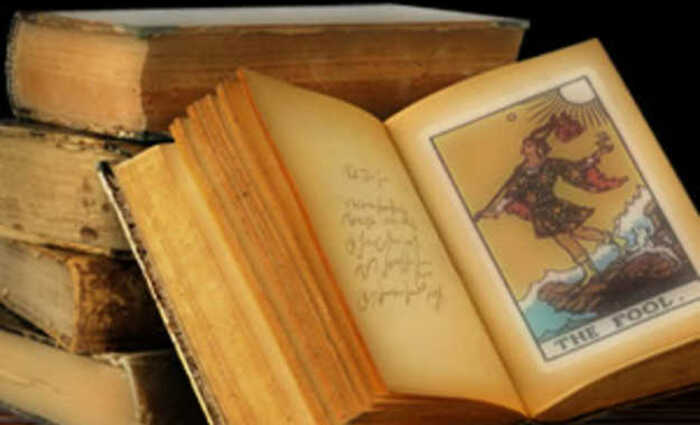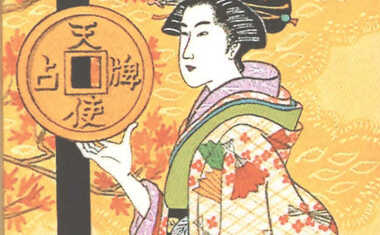
Joachim of Fiore
Discover the story of the legendary Joachim of Fiore
Part V: Joachim of Fiore
To understand the transformations that occurred in Catharism, we must pause to consider the strange mystic and prophet, Joachim of Fiore. Too "Catholic" for the occultist historian and too "heretical" for the orthodox, he appears more often in footnotes than in the text of history books. It has only been in recent decades that his incredible influence on the intellectual history of the Middle Ages and Renaissance has become the subject of scholarly research. Recently, Betts (1999) has written a book-length treatment of how much the Tarot owes to the apocalyptic vision that was his heritage.
Joachim was not a heretic in the European fashion--he was not a wandering hermit preaching against the corrupt Church and advocating a return to Apostolic poverty. Born c1135, Joachim became a cloistered Cisterian monk, formed his own Order of S. Giovanni in Fiore in 1196 and died there in 1202 (Reeves, 1976). Those dates mean that he was alive during the flowering of Catharism. But his influence was not felt until later through his writings on a prophetic interpretation of history. Throughout his life, he remained a faithful servant of the Church, and although some of his teachings were condemned, his personal sanctity was never questioned. Reeves (1969) points out that his position in the Church has always been ambiguous. He is listed in the official Acta Sanctorum as "beatus," but he is also listed as a heretic in the official Catalogus Haereticorum. Dante gives him a high place in Paradisio, possibly as a cynical jab at the Church's ambiguity.
Joachim's original vision of history was complex, and the details and numerology evolved through his writings. But the original complexity need not concern us because it was the popular commentaries, rather than Joachim's original writings, that had the real influence. Seen through the eyes of the commentators, the basic structure of Joachim's theory has an uncanny resemblance to the Fool + 21 trumps structure of the Tarot. For example, Joachim uses the analogy of the pilgrim (Reeves and Hirsch-Reich, 1972) very much as modern writers use the "Journey of the Fool" to describe the basic structure of the Tarot.
For Joachim, the basic unit of history is the Status (Status=age or stage). History is divided into three ages, each with seven steps. The first status is the age of the Father, captured in the Old Testament, with seven steps represented by the seven seals mentioned in the book of Revelation. This first age had a germination period of 3x7 = 21 generations from Adam to Jacob and a fruition period of 3x7 = 21 generations from Jacob to Ozias. The second status is the age of the Son, with seven step represented by the opening of the seven seals in the book of Revelation. This second age had a Germination period of 3x7 = 21 generations from Ozias to Jesus and a fruition period of 3x7 = 21 generations from Jesus to St. Benedict.
The third status was the age of the Holy Spirit with a germination period of 3x7 = 21 generations from St. Benedict to ??????? and would have a final fruition period of 3x7 = 21 generations from ?????? to the "Consumatio Seculi," the end of time (Reeves and Hirsch-Reich, 1972). Later commentators were to simplify this so the transition to the age of the Holy Spirit was occurring during their own time. However, they retained the basic three and seven structure that might be represented in the Tarot trumps.
There is another aspect of Joachim's writings that offers an alternative to the typical interpretation of the two pillars in the Tarot as Boaz and Jachin of the Temple of Solomon. In Joachim, "The two testaments stand like everlasting pillars to the end of time, and upon them must the spiritual structure of the third status be built....They are the feet of the angel of the Apocalypse 10:1 as pillars of fire, and later the earth and sea upon which he plants his feet." (Reeves and Hirsch-Reich, 1972).
Thus, the two pillars become the Old and New Testament upon which the Church rests. A remarkably simple and orthodox explanation for symbolism that has often been offered as proof of Judaic influence on the symbols. In other places, Joachim uses a diagram of two pillars, representing the parallel history of the Ordo monachorum and Ordo clericorum (Reeves and Hirsch-Reich, 1972). So throughout history there will be a dual structure of civic and religious infrastructure and hierarchy. Given the parallel Tarot symbols of religious Papess/Pope and civic Empress/Emperor infrastructure, this offers another simple and orthodox explanation of the dual pillars.
Although Joachim offered a complete theory of history, it was his prediction of the immanent transition to a new age that attracted the most attention. His theory was taken as an apocalyptic vision. And that vision, of course, goes to the very heart of Christianity (McGinn, 1994). In the Gospel of Matthew, we find Jesus saying: "For the Son of Man shall come in the glory of his Father with his angels; and then he shall reward every man according to his works. Verily, I say unto you, there be some standing here, which shall not taste death, till they see the Son of Man coming in his kingdom."
The early Christians viewed themselves as the fulfillment of Judaism and the beginnings of a new age. They expected Jesus to return any day and announce the final judgment and the end of time. The Church Fathers, particularly Origin, labored hard to explain the words of Jesus as referring to the personal salvation of the individual, rather than referring to the end of time (Cohn, 1957). In spite of the success of that explanation, Christianity has remained an apocalyptic religion and the last book of the New Testament, Revelation or Apocalypse, is very much a vision of the end-times. Throughout the ages, this prophetic book was seen as the ultimate esoteric/occult text. There was much hidden behind the symbolism.
The apocalyptic vision remained as a heterodox element of Christianity. In 156 AD Montanus of Phrygia announced that the New Jerusalem of Revelation was about to descend (Cohn, 1957). His movement was widespread, spread throughout the Roman Empire even to Gaul. Irenaeus from Asia Minor settled in Gaul toward the end of the second century and did much to establish the apocalyptic outlook in the west (Cohn, 1957). Early Christian writers often referred to the books of the Apocrypha and Pseudoepigrapha (Charles, 1913; James, 1924). These books were full of apocalyptic prophesies but were dropped from the official canon of the Protestant Bible although the Apocrypha remains in the Roman Catholic Bible.
Indeed, there was hardly a time in Europe without wandering lay preachers announcing the immanent end of time and the need for repentance and asceticism in preparation. There is documentary evidence from France 591AD and 744AD, Flanders 1112AD, Italy and Provence 1116AD, Brittany 1145AD and 1224AD (Cohn, 1957). Adso of Montier-en-Der (c950 AD) was already anticipating many of the detailed predictions of Joachim, such as the coming of the Anti-Christ and a Frankish ruler who would restore the Roman Empire in the West (McGinn, 1979). So Joachim was addressing a Christian audience that was well-prepared to receive his message.
Much of Joachim's work is visionary, and he makes use of a number of diagrams. One of his primary figures is a tree of history with three branches and seven leaves on each branch. He specifically calls this the Tree of Life. Similar tree diagrams were well established in Christian art by the 12th century (Reeves and Hirsch-Reich, 1972), and it is possible that Joachim got the idea of the tree from these sources. However, his use of a diagram for the Tree of Life more than two centuries before it appears in QBLH does give one pause! Joachim's birthplace in Calabria had a vigorous Jewish community, and we know that he undertook a pilgrimage to the Holy Land in his youth.
Indeed, he himself may have been of Jewish origin, though this has been disputed (Reeves, 1976). "One of the few contemporaries, however, whose influence he acknowledged was Petrus Alphonsi, a Spanish Jewish convert, and it may be that Joachim's whole sense of the Godhead at work in the very stuff of history itself springs from deep Hebraic roots" (Reeves, 1976). And again, "There seems little doubt that Joachim drew on Jewish mysticism through the converted Spaniard" (Reeves and Hirsch-Reich, 1972). However, Joachim's tree is quite different from the 10/22 structure that first appears in the 16th Century and is the tree traditionally applied to the Tarot. Scholem (1941) briefly examines the possible connection of QBLH with Joachim and concludes that a direct influence is doubtful.
While it is difficult to demonstrate a tie to QBLH in Joachim's work, we can be fairly certain about the Neoplatonic influence. For example, he adopts the nine hierarchies of angels from the Neoplatonist Pseudo-Dionysius (Reeves, 1976). On the other side of the coin, the Neoplatonist, Nicholas of Cusa, was very interested in apocalypticism and wrote a treatise "Conjecture regarding the Last Days" about 1440 (McGinn, 1998). The Neoplatonist Giovanni Nesi wrote "Oracolo de novo saeculo" in which he integrated Neoplatonism with the prophetic tradition of Joachimism (Reeves, 1976).
The close ties with Joachimism are important because dualism is a fundamental premise in Neoplatonism (Daniel, 1992). To Plato, Plotinus, and the Hermetic philosophers, the fundamental problem of philosophy was the tremendous gap between the infinite, eternal, immutable spirit of the One and the finite, temporal, mutable material world. The emanations of the Neoplatonists, the sephiroth of QBLH, the Incarnation of Jesus, and the radical dualism of the Gnostics are all proposed solutions to this same problem and all originate in the Alexandrian/Greek synthesis of the first centuries of the present era. As Joachimism became blended with Catharism, it was relatively simple to transform the radical dualism of the Cathars (which is NOT represented in the Tarot) into the more orthodox expression of dualism in Neoplatonism (which MAY be represented in the Tarot).
Our primary interest is in showing how Joachimism influenced Catharism and helped to transform it. However, it is also important to realize that Joachim's vision of history was extremely influential in its own right (Leff, 1967). By 1248, there was already an elite group at Hyeres in Provence, including lawyers, doctors and other literati, studying and discussing Joachim's prophesies (Reeves, 1976). From the beginning of the 13th century through the 16th century, there was a general impression that a new age of the Holy Spirit was dawning and the world was soon to end (Wylie, 1996). Joachim's vision is very much a part of this development and we find him discussed by Jean de Roquetaillade 1344, Telesphorus of Csenza 1390 and Pierre d'Ailly 1414 (Reeves, 1976). Joachim's ideas were readily accepted into the syncretism of the Renaissance because their vision of a new classical golden age fit well with the emergence of an Age of the Spirit.
Joachim also fit neatly into the esoteric and mystical interests of the Renaissance. His interpreters saw the dawning age of the Spirit as providing new access to the great mysteries, "the further spiritual illumination prophesied by Joachim chimed with the new learning and especially with the forms of secret and mystical knowledge pursued by some of the Platonists" (Reeves, 1999). "By all avenues of knowledge, occult as well as open, it was his (man's) destiny to ascend to celestial secrets. Alchemy, magic, the cabbala, astrology, prophesy, could all be viewed as aspects of the veiled language in which the Eternal divulged the fundamental secrets of existence." (Reeves, 1976).
In the early 16th century, Cardinal Egidio of Viterbo, General of the Augustinian Hermits, met in Venice with Silvestro Meuccio, the editor of Joachim's works. Egidio was a Neoplatonist and student of Hebrew literature, especially the mysticism of the cabala. He gathered within his household humanist scholars in Greek, Hebrew, and eastern languages. He believed it possible to read the divine thoughts through number symbolism and concordances (Reeves, 1976). John Dee, regarded by Yates (1972) as a source of Rosicrucianism, was interested in Joachim's number symbolism. It seems probable that a figure of circles in a Rosicrucian work by Franckenberg, "Raphael oder Arztengel" was modeled after Joachim's figura of the Wheels of Ezechial (Reeves, 1976). So Joachim had a significant impact in his own right, irrespective of his role in transforming Cathar dualism.
Joachim also fit neatly into the popular culture and its fascination with prophesy, divination and apocalypse. Prophesy and divination were a part of everyday urban life (Niccoli, 1987). It was preached from the pulpit and in the piazzas. Of particular interest are the printed prophesies or "broadsheets" that were displayed, sold, and discussed in the market. Printed in the same shops that produced the early woodblock Tarot decks, they contained vernacular verse with images. We have about twenty Italian examples from 1480-1530 (Niccoli, 1987). The concept that the early Tarot had a connection with prophesy and divination becomes more feasible the more we learn about the popular culture of the Italian towns of the 15th century.
It is time now to return to our main theme--the possible influence of Catharism on the Tarot symbols. But to understand the complex transformation that occurred, we must next look at another incredible genius of the time--St. Francis of Assisi.
References
Betts, T. 1999. The Tarot and the Millenium.
Charles, R. H., ed. The Apocrypha and Pseudoepigrapha of the Old Testament in English. 1913. Oxford University Press. rprtd. 1978.
Cohn, N. The Pursuit of the Millenium. 1957. Oxford University Press rprtd. 1970.
E. R. Daniel. 1992. Joachim of Fiore: Patterns of History in the Apocalypse. 72-88 IN R. K. Emmerson and B. McGinn, eds. The Apocalypse in the Middle Ages. Cornell University Press, Ithaca, NY.
James, M. R. 1924. The Apocryphal New Testament. Oxford Univesity Press. rprtd. 1975.
Leff, G. 1967. Heresy in the Later Middle Ages: The Relation of Heterodoxy to Dissent c. 1250-1450. Manchester Univ Press, Manchester.
McGinn, B., trans. 1979. Apocalyptic Spirituality. Paulist Press.
McGinn, B. 1994. Apocalypticism in the Western Tradition. Ashgate Publishing, Brookfield, Vermont.
McGinn, B. 1998. Visions of the End. Columbia University Press, NY. 1979. Columbia University Press, NY.
Niccoli, O. 1987. Prophesy and People in Renaissance Italy. Gius, Laterza & Figli, Roma-Bari. rprtd 1990. Princeton University Press.
M. Reeves. Joachim of Fiore and the Prophetic Future. 1976. SPCK, London. 1999 edition Suton, Gloucestershire. abbrev JF.
Reeves, M. 1969. The Influence of Prophesy in the Later Middle Ages. Oxford University Press. rprtd. University of Notre Dame Press, 1993.
Reeves, M. and B. Hirsch-Reich. 1972. The Figurae of Joachim of Fiore. Oxford University Press, Clarendon Press, Oxford.
Reeves, M. 1999. The Prophetic Sense of History in Medieval and Renaissance Europe. Ashgate Publishing, Vermont.
Scholem, G. 1941 Major Trends in Jewish Mysticism. Schocken Books, Jerusalem. rprtd. 1961.
Wylie, J. A. 1996. History of the Waldenses. Cassell and Company, Ripitan, VA.
Yates, F. 1972. The Rosicrucian Enlightenment. Routledge and Kegan Paul, NY.



